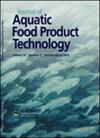The Combined Effect of Beetroot Peel Extract, Chilling, and Vacuum Packaging on the Shelf-Life of Deccan Mahseer (Tor khudree) Steaks
IF 1.3
4区 农林科学
Q4 FOOD SCIENCE & TECHNOLOGY
引用次数: 1
Abstract
ABSTRACT The effect of beetroot peel extract (BPE) on the quality of vacuum-packed fresh mahseer steaks (Tor khudree) was evaluated under chilled conditions (2°C) over a period of 15 days. Liquid chromatography mass-spectrometry (LC-MS) analysis was used to quantify BPE for the characterization of phenolic and flavonoid compounds. The fish samples were analyzed for sensory, biochemical, and microbiological parameters. Treatments included the following: CtAP (control samples, untreated: air packed), CtVP (control samples, untreated: vacuum packed), and BtVP (vacuum packed, treated with BPE 20% v/v). When comparing CtAP and CtVP mahseer steaks to BtVP mahseer steaks, the total plate count was higher, followed by the Enterobacteriaceae count. Based on the changes in quality indices, beetroot peel extract treated steaks showed significant (P < 0.05) control over lipid oxidation and microbial growth compared to CtAP and CtVP steaks throughout the storage. As per the sensory analysis, air-packed steaks were found to have a shelf life of about 9 days; vacuum-packed steaks were found to be acceptable for 12 days, whereas beetroot peel extract treated vacuum-packed steaks were acceptable for 18 days. Consequently, vacuum-packaging in combination with BPE treatment was found to delay the spoilage phenomenon, thereby increasing the shelf life of mahseer steaks.甜菜皮提取物、冷藏和真空包装对德干马希尔牛排保质期的综合影响
摘要:甜菜根皮提取物(BPE)对真空包装新鲜马希尔牛排(Tor khudree)质量的影响在冷冻条件下(2°C)持续15年进行了评估 天。液相色谱-质谱(LC-MS)分析用于定量BPE,以表征酚类和类黄酮化合物。对鱼类样本进行了感官、生化和微生物参数分析。处理包括以下内容:CtAP(对照样品,未处理:空气填充)、CtVP(对照样品、未处理:真空填充)和BtVP(真空填充,用20%v/v的BPE处理)。当将CtAP和CtVP mahseer牛排与BtVP mahsere牛排进行比较时,总平板计数较高,其次是肠杆菌科计数。根据质量指数的变化,与CtAP和CtVP牛排相比,甜菜根皮提取物处理的牛排在整个储存过程中对脂质氧化和微生物生长表现出显著的控制(P<0.05)。根据感官分析,充气牛排的保质期约为9年 天;真空包装牛排被发现可接受12份 天,而甜菜根皮提取物处理的真空包装牛排可以接受18天 天。因此,发现真空包装与BPE处理相结合可以延缓腐败现象,从而延长马希尔牛排的保质期。
本文章由计算机程序翻译,如有差异,请以英文原文为准。
求助全文
约1分钟内获得全文
求助全文
来源期刊
CiteScore
3.50
自引率
6.20%
发文量
77
审稿时长
7 months
期刊介绍:
The Journal of Aquatic Food Product Technology publishes research papers, short communications, and review articles concerning the application of science and technology and biotechnology to all aspects of research, innovation, production, and distribution of food products originating from the marine and freshwater bodies of the world. The journal features articles on various aspects of basic and applied science in topics related to:
-harvesting and handling practices-
processing with traditional and new technologies-
refrigeration and freezing-
packaging and storage-
safety and traceability-
byproduct utilization-
consumer attitudes toward aquatic food.
The Journal also covers basic studies of aquatic products as related to food chemistry, microbiology, and engineering, such as all flora and fauna from aquatic environs, including seaweeds and underutilized species used directly for human consumption or alternative uses. Special features in the journal include guest editorials by specialists in their fields and book reviews covering a wide range of topics.

 求助内容:
求助内容: 应助结果提醒方式:
应助结果提醒方式:


